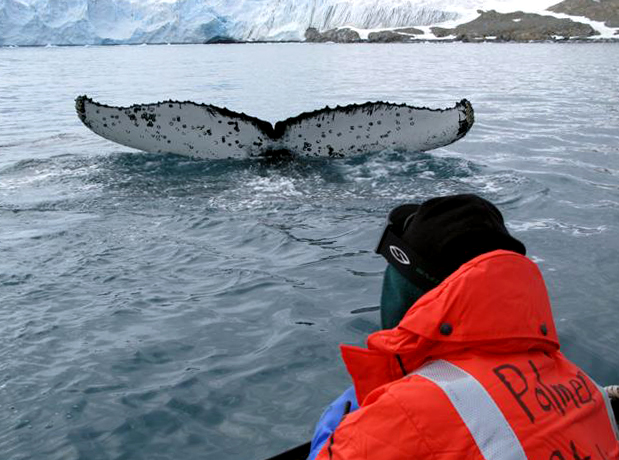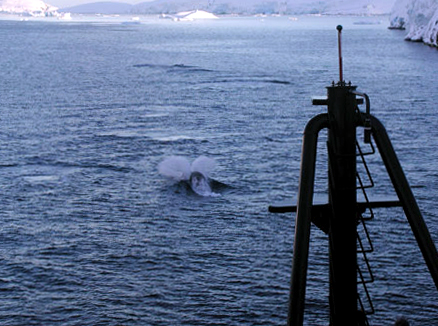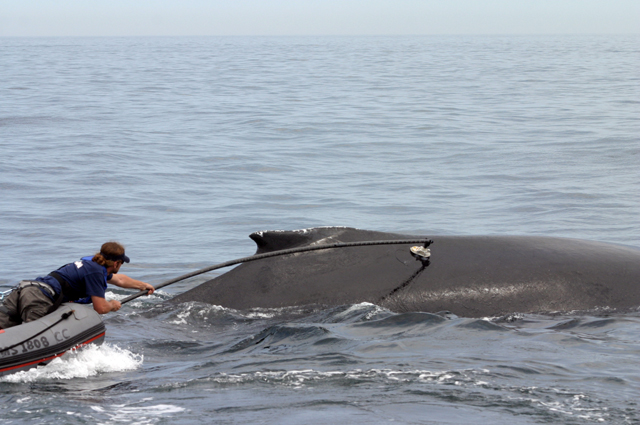TaggedTechnology to help scientists measure krill consumption by humpbacksPosted March 20, 2009
Just what does a humpback whale in the Southern Ocean do all day? Well, eat, that’s for certain. A lot. But how much of the shrimplike krill It’s a question that a team of scientists, led by Douglas Nowacek Krill is the preferred meal for many of the apex, or top, predators in the region, such as seals, penguins and whales like the humpback, which can grow up to 16 meters long. But little is known about the ecology of one of the Southern Ocean’s largest, most voracious feeders. “There’s already quite a bit of information on diving patterns, feeding patterns, feeding rates and energetic rates for the other krill predators,” explained Ari Friedlaender “What we want to do with whales is to understand how much they eat in a given day, the threshold of prey necessary for them to be able to forage, and how they make decisions about feeding,” he added. Quantifying the consumption rates is important for understanding the bigger ecological picture of the Antarctic Peninsula, parts of which are becoming more subantarctic as climate changes. Scientists have noted a decline in krill biomass, which they say is linked to the declining duration of winter sea ice, a key habitat for juvenile krill. Changes in the climate, particularly in the winter, are affecting the sea ice. 
Photo Credit: Rebecca Shoop/Antarctic Photo Library
The tail of a humpback whale appears near Palmer Station.
Meanwhile, humpback whale populations have rebounded over the last two decades since a moratorium on whaling went into effect in 1986. The International Whaling Commission And commercial fishing of krill, while relatively low and below peak numbers in the 1980s, could increase as industries look for additional sources of fish farm food and additives for omega-3 supplements. These mounting pressures on the krill population make it necessary to understand the humpback whale’s role in the equation by putting some hard numbers on consumption rates, according to Nowacek. “It’s a fairly lofty goal, but it’s something that we have the pieces to put together,” he said. A technology he helped develop as a graduate student, the acoustic recording tags are a noninvasive way of not just tracking the animals but recording their acceleration, movement and heading — information the researchers can use to help characterize feeding behavior. For example, there is a certain signal from that tag that links to what Nowacek calls a “feeding lunge.” “Getting the feeding lunges is a key, so that every time they feed you assume they fill up their mouths,” he said. The tag, about the size of a paperback novel, contains sensors and a hard drive, and attaches to the whale by suction cups. It can also record the whale’s vocalizations, allowing scientists to listen as whales feed and interact underwater, as well as eavesdrop on seals and other biological drums that may be beating nearby in the area. The technology is unique. The technique to get close enough to one of these 35-ton behemoths, with its unusually long pectoral fins and knobby head, requires a soft touch. “It’s not routine. You definitely have to know what you’re doing,” Nowacek said. “Some whales are not interested in being tagged, and they just take off — and you just leave those alone.” Tagging techniques vary by species, said Friedlaender, who has tagged killer, sperm, pilot and humpback whales, among others. Maneuvering by a small boat, like the inflatable Zodiacs used by the U.S. Antarctic Program (USAP) “In a small boat we try to approach the whales as stealthily as possible, and then literally we just slap the tag on the whale,” Friedlaender said. The suction cups then activate and the tag remains on the animal until it drops off as programmed. Friedlaender and colleagues have worked with humpbacks off the New England coast for the last five years, so the team is familiar with how the whales move and surface. Still, their southern cousins are just different enough to require a bit of a learning curve, he said. “In the Antarctic, it will take us a little while to get in a rhythm of how the animals are feeding. 
Photo Credit: Rebecca Shoop/Antarctic Photo Library
The Gould follows a humpback whale as it navigates the water around the Antarctic Peninsula.
“When it works, it looks easy. It looks like a baseball swing: When you see a guy hit a homerun, it looks simple,” he said. “It’s pretty challenging.” The team riding in the tagging boat is only one of four to the Antarctic operation. One team on the Gould is on point to spot whales, while a second crew aboard ship uses instruments, such as an echo sounder, to measure the mass of krill in the whale’s hunting ground. A fourth team rides in a second Zodiac that follows behind the whale, also to measure the krill mass left in the creature’s wake. If the scientists can determine the amount of krill pre- and post-gulp by the whale, they can pretty accurately measure each mouthful, because they already have a good idea of the size of its gular, or “throat,” pouch. The project is something of a follow-on from Friedlaender’s PhD work on the Southern Ocean Global Ocean Ecosystems Dynamics (SO GLOBEC) “We found some very different things between humpbacks and minke whales,” he said. For instance, it appears the humpbacks hunt in more shallow waters while minkes dive deeper in the ocean to feed, implying that they don’t conflict over resources. While the upcoming project focuses on humpbacks, Friedlaender said the scientists also hope to learn more about minkes, a smaller, more elusive baleen whale that lives in the Southern Ocean year-round. “We had the idea that we wanted to do some very focused studies of the diving behavior and the feeding behavior of these two whale species, and see if in fact there is this separation between these two species, [and] how exactly are they doing it,” he explained. This April will be Nowacek’s first foray into Antarctic waters. “It was a challenging area to go. It was an animal that we had some expertise on already. We felt we could bring something new to the table,” he said of the impetus to leave the familiarity of the northern hemisphere. “The attraction was working on a cool species and interesting problem, using a technology that nobody else could bring to bear.” Added Friedlaender, “We’re going to have the prettiest office in the world. There’s not a lot of places like the Antarctic Peninsula to be able to do your work. We’re really pretty fortunate to work in such a cool place.” NSF-funded research in this story: Douglas Nowacek, Duke University, Award No. 0739483 |



For USAP Participants |
For The Public |
For Researchers and EducatorsContact UsNational Science FoundationOffice of Polar Programs Geosciences Directorate 2415 Eisenhower Avenue, Suite W7100 Alexandria, VA 22314 Sign up for the NSF Office of Polar Programs newsletter and events. Feedback Form |


